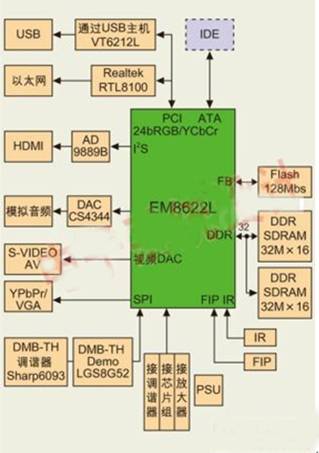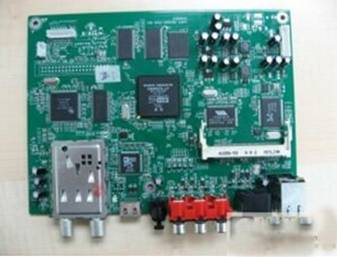With the popularity of full HD flat-panel TVs, more and more consumers have experienced the charm of high-definition digital TV. There are two main sources of HD signal sources: one is HDTV and the other is network. Many consumers download movies from the Internet to watch, but the effect on the computer monitor is far less than watching on TV. Taking into account the needs of this part of the consumer, Shijian System has developed an integrated solution for national standard HD digital TV reception and streaming media playback.
This article refers to the address: http://

The media decoding part selects Sigma Design's EM862X series chip as the core of the product, and uses Legend Silicon's LGS-8G52 (simultaneous support for single-carrier and multi-carrier) demodulation chips as the front-end design to achieve the best performance. Can support broadcast modes in different regions.
Hardware system architecture design
The program's video output interface supports HDMI, YPbPr, VGA, S-Video and CVBS, so customers can choose different LCD TV platforms as the back end for video processing. This overall solution, combined with the Pixelworks PW338+PW9800's 120Hz LCD TV solution, can create a high-performance all-in-one platform.
The digital tuner uses Sharp's VA1T1ED6093, a full-range digital tuner developed by Sharp for the DMB-TH standard. It has a receive frequency range of 47MHz to 870MHz and an IF bandwidth of 8MHz. By adopting the latest demodulation chip LGS-8G52 of Lingxun Technology, the intermediate frequency signal output by the tuner is converted into digital intermediate frequency signal by A/D built in LGS-8G52, and then demodulated and output as MPEG2-TS (Transport Stream) stream. And support 8-bit parallel or serial TS streams at the same time. The LGS-8G52 chip is the latest product of Lingxun Technology. It optimizes the processing of impulse noise, echo and attenuation. The stability and power consumption are greatly improved. The application on the flat panel TV will not cause the temperature to be too high. The picture quality situation.
The media decoding part adopts EM8622 of Sigma design. The EM862X chip has high-definition decoding and playback capability, and supports MPEG2 and H.624 decoding, and can output 1080P HD format. The EM8622 is a 200MHz ARM core master. The 32-bit DSP is dedicated to audio processing, the 16-bit RISC processor is responsible for video decoding, and the 32-bit RISC processor core is responsible for demultiplexing. The decoding function passes the input MPEG2-TS stream through the hardware decoding technology, and returns the basic audio and video code stream, and stores it in the SDRAM, and then decodes the basic video stream into video data through the video decoding function module, and then performs video processing. The function module and image mixer output the video data and the menu data.
The EM8622 supports multiple video transmission modes, including digital mode and analog mode. Digital mode supports 8-bit, 16-bit YCbCr 4:2:2 mode, 24-bit YCbCr 4:4:4 mode, 24-bit RGB mode, BT.601 and BT.656, which can directly drive the LCD screen, or pass The HDMI circuit (AD9889B) sends a chip to output digital HD images. The analog video output supports NTSC and PAL CVBS format, S-Video format, YPbPr and RGB formats. Both digital and analog output modes support the 1080P format, so the EM8622 is ideal for cross-platform module design. The audio signal is input to the audio processing function module through the I2S or SPDIF serial digital interface, and the function module supports linear PCM format, MP3 encoding format, AAC-LC 2.0 format, HE-AAC 2.0 format, BSAC format, Dolby Digital 5.1 format, DTS 5.1 format, etc. The sound processing function module outputs audio data to the digital-to-analog converter (CS4344) through S/PDIF or I2S, converts the digital audio data into an analog audio signal, or transmits it to the terminal device via an HDMI transmitting chip (AD9889). In the design of the all-in-one, the video signal is input to the PW328 image processor for further processing. Since 100/120Hz LCD panels will be introduced to the market, the expansion interface is considered in the design of the all-in-one, and the module supporting the 100/120Hz LCD panel is designed.

Software system architecture design
Due to the need to support more video formats, and the technical requirements of GB20600-2006 and the scalability of software, the software system adopts modular design. The whole software architecture can be divided into operating system, graphical user interface, application part and middle. Part.
Because of the need to use Flash to record data, pre-recorded data, etc., the program must have a Flash operation module (including the Flash driver), and can read and write to Flash. The program search module performs automatic search and manual search and sorting, and then stores the search results through the Flash operation module. The program editing module provides functions such as locking favorite programs or skipping. Locking is also possible, and a preset password is required to switch to a program to view.
The program recording module is responsible for writing the MPEG2-TS stream file of the corresponding program to the mobile hard disk or the memory card through the USB interface, and the further scheduled video function is set by the program reservation module, which can manage the reservation type of the program and follow the reservation. The time to perform recording start and end, including instant recording, timed recording, and EPG recording, and excludes time conflicts for scheduled recordings. The USB interface playback module mainly manages the connection status of the USB memory. The module can display the file name and type, play the selected file, and can prompt correspondingly, and provide corresponding functions during playback (such as fast forward, backward, pause, Recovery, etc.). You can also manage stored files, delete files and format them. The network play module is used to play audio and video files in the network share folder. The software upgrade module allows users to upgrade in three ways: serial port, USB interface and network, etc., responsible for upgrading the user selected target program. The demultiplexing module is used to process TSD channels, filters, buffer management (including setting PID, de-PAT table, PMT table, SDT table, etc.), setting filter conditions, managing channel buffers, and performing CRC verification. The EPG module can process and display 7-day EPG information and is responsible for the setting of EPG recording.
This article discusses the design of HDTV integration. The analog and digital output interfaces support 1080P resolution. EPG realizes the display of 7-day program information, and can set video reservations according to events. Support USB2.0 protocol, with The USB interface plays the function of playing high-definition video documents, and supports a wide variety of audio and video documents; it supports network transmission and realizes the function of network player. The design uses the LGS-8G52 to support national standards (ie, single-carrier and multi-carrier simultaneous compatibility). In addition, the network features will be upgraded to support wireless networks.
Cummins 0-20KW Diesel Generator
Cummins 0-20Kw Diesel Generator,Cummins Portable Power Generator,Cummins Open Type Power Generator,Cummins Container Power Generator
Shanghai Kosta Electric Co., Ltd. , https://www.ksdgenerator.com